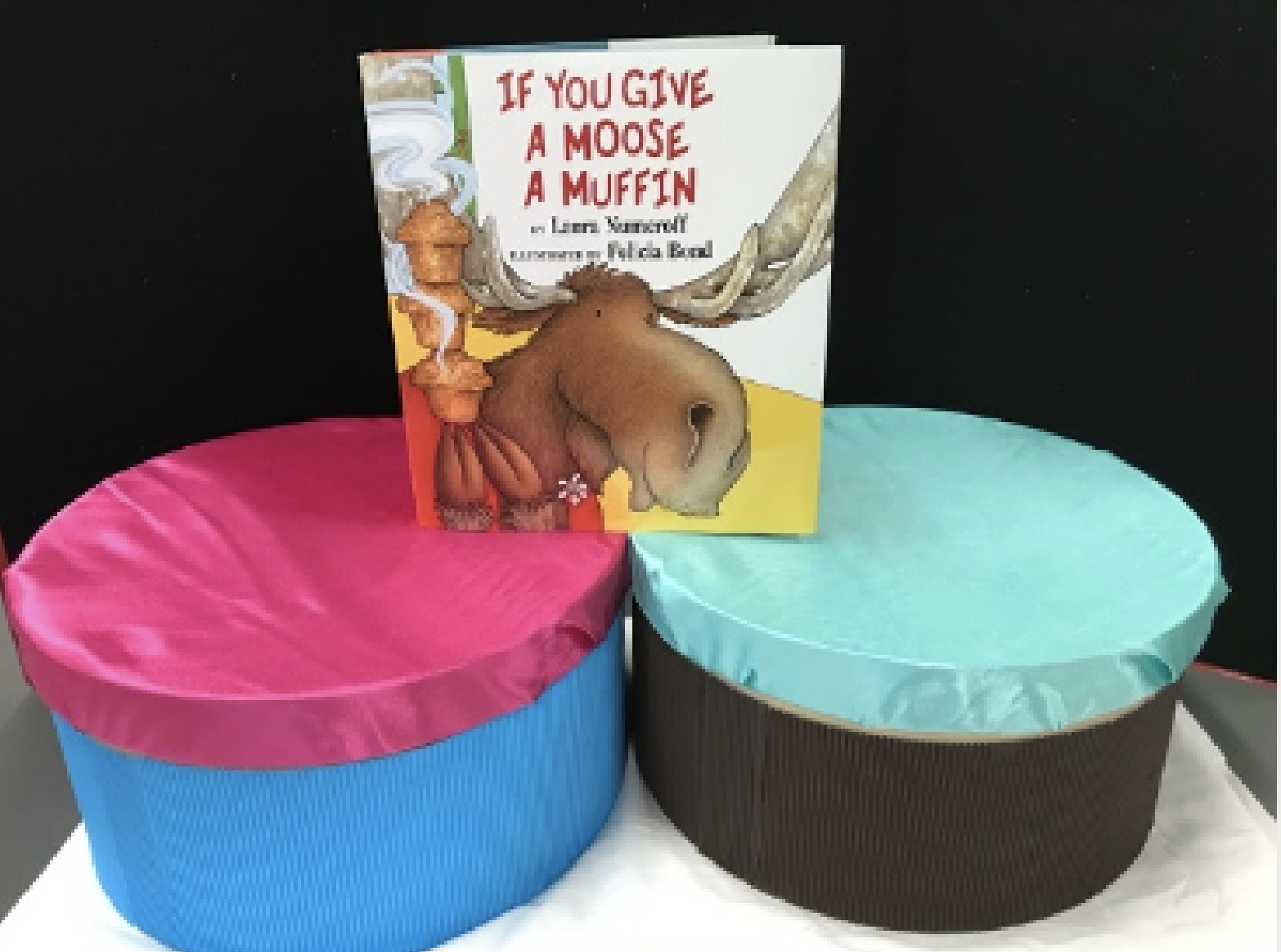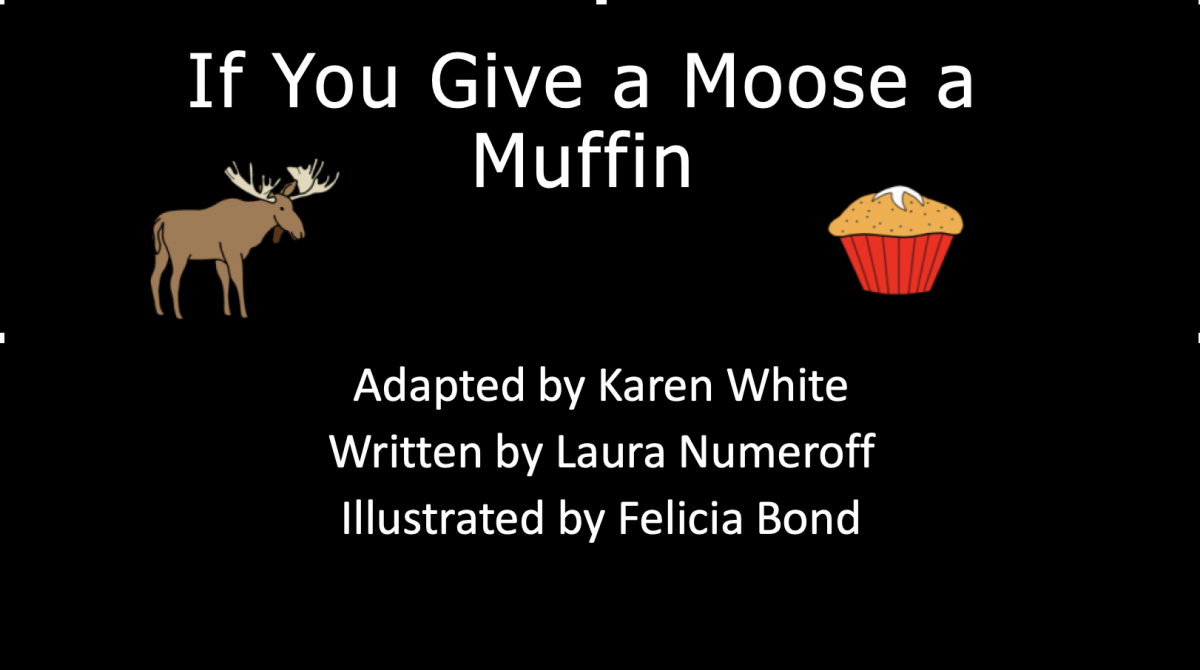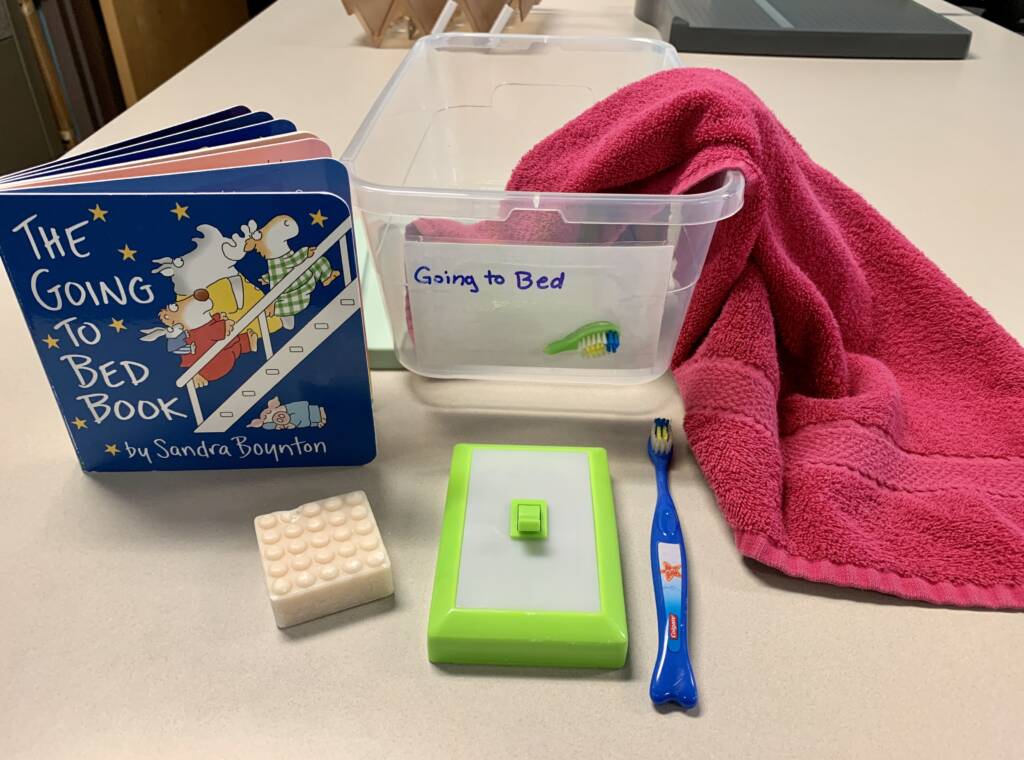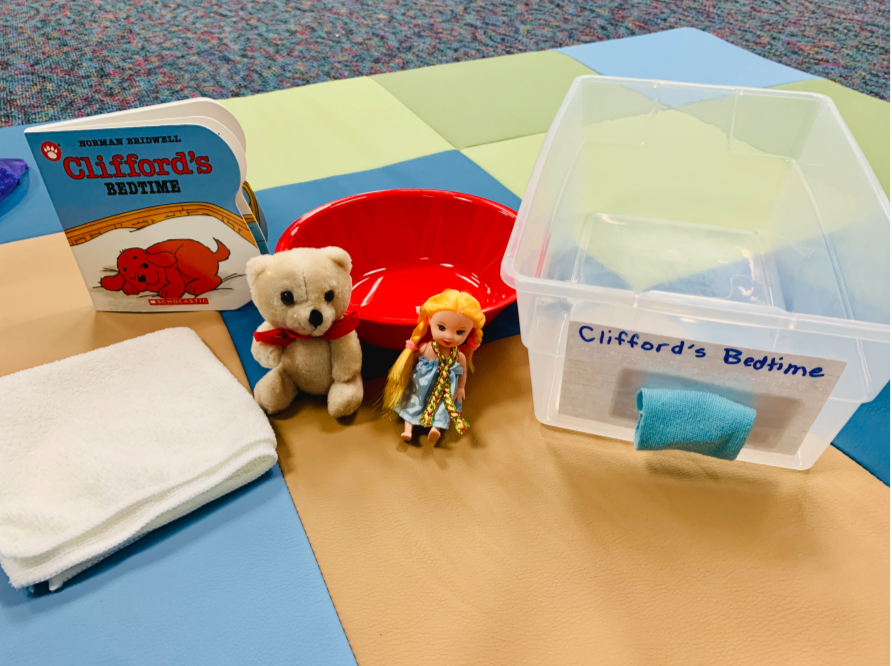As part of the graduate coursework for Visual Impairments and Multiple Disabilities in the Teacher Preparation Program in Visual Impairments at the University of Kentucky, students were asked to complete four projects: a Story Box with at least 10 objects that correspond to the story, picture communication symbols and tactile communication symbols designed to go along with the story, and a talking book to go along with the story or represent concepts from the story.
We are sharing them on Paths to Literacy and hope that others will use them!
Story Box
The story I have chosen to use for the story box project is If You Give A Moose a Muffin written by Laura Numeroff and Illustrated by Felicia Bond. This story is part of a very beloved and familiar series in most preschool and early elementary programs. The book is entertaining, colorful, fun and follows a predictable pattern. I would recommend this book for students with visual impairments and multiple disabilities due to the opportunities afforded students to explore a variety of real-life materials in order to expand upon concept development, as well as to engage in the predictive and fun storyline of the book.
The objects I chose use for my story box were:
- Stuffed Moose- a brown, fuzzy moose with two antlers, four legs, facial features and a tail
- Moose fur- brown, high -pile and fuzzy fabric
- Antlers metal with textured ridges along the surface
-
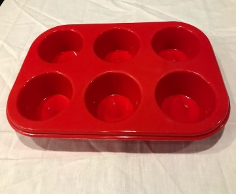 Muffin Pan- a red, silicone 6 muffin baking dish
Muffin Pan- a red, silicone 6 muffin baking dish - Muffin Liners- various colored paper muffin liners
- Blackberry Jam- a glass jar of Smucker’s Blackberry jam
- Spoon- a black, plastic spoon
- Muffin mix- a paper package of Betty Crocker muffin mix
- Sweater- a pink, little girl’s sweater made of wool
- Soap- a bar of yellow, Dial antibacterial soap
- Needles- a package of two small knitting needles with no-sharp points and wide eye holes
- Thread- a spool of yellow thread
- Cardboard- a rectangular piece of brown cardboard
- Paint Brush- a small red handled paint brush
- Paint Set- a set of Crayola Watercolor paints with various colors (red, yellow, blue, green and purple).
- Sheet- a white, twin-sized cotton flat bed sheet
- Clothespin- a wooden clothespin
- Button- a green, medium-sized plastic button
- Socks- a pair of white adult-sized tube socks
Additional options: When I am using this story box, I hope to also introduce real muffins to the experience and allow the students to spoon blackberry jam onto the muffins. In addition, another great concept that I have adapted is using yarn to thread the wide knitting needles in order to gain a better concept of the idea of sewing and threading a needle.
Storage Container:
I chose to use two round, paper-mache boxes as the method of storing my story box. I used corrugated cardboard and glued them on the outside edges of the boxes to replicate the texture of a muffin liner. For the tops of the boxes, I glued silk material to give the smooth texture of the top of a muffin. I then tied the two boxes together using a scarf.
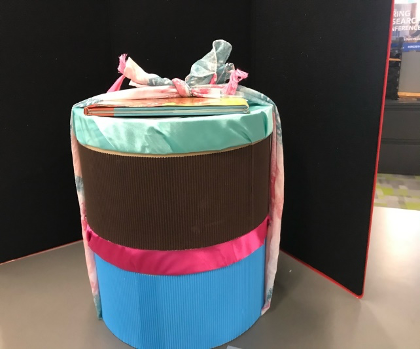
Implementation Ideas:
- Object Exploration: The story box could be introduced as a tactile walk, giving the children the opportunity to explore the items with their sense of touch before the story begins in order to begin the story with a sense of familiarity with the concepts and objects mentioned in the book.
- Entire Class Activity: The story could also be used as a large group activity, small group activity setting, or as part of a center in a classroom.
- Comprehension: Using objects in the story box, students can answer comprehension questions about the story.
- Retelling Story: The objects can be used to retell the story. The objects will also provide the students with the background knowledge needed for the picture cards and tactile symbol cards. Students can explore the object as it is being discussed/read in the story.
- Sequencing: Using the objects in the story box, students will be able to sequence the events of the story.
- Preparation: The items in the story box will be a great tactile introduction of the concepts and objects in the story as necessary for using the picture identification and tactile identification cards.
Tactile Symbols
The objects I chose to use for the project are eight objects mentioned in the story, one character in the story, and one action in the story.
- I chose to use the main character of the book, the Moose, as a character symbol, placing it on a yellow “people” APH Tactile Symbols card. The object used for the Moose is brown, fuzzy, high-pile material to represent moose fur.
- I chose to place part of a black spoon to represent eating, on a green “action” APH Tactile Card. I chose to use the spoon as a core vocabulary word and the moose eats many muffins during the course of the story. I felt using a core vocabulary word would be useful to build on the student’s vocabulary throughout routines each day, as well as during the story activities.
-
The “object” cards (white/rounded APH Tactile Symbol cards) that I made are:
- Square of white, cotton material to represent a sheet
- Wooden clothespin to represent a clothespin
- White, large plastic button to represent a button
- Brown, rectangular piece of cardboard to represent cardboard
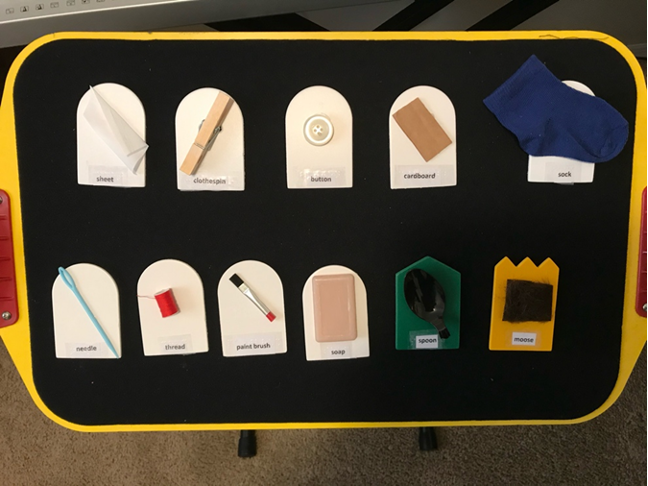
Picture Symbols
I chose to make picture communication symbols to accompany the book If You Give a Moose a Muffin by Laura Numeroff using the BoardMaker Online program. I chose pictures that were key components, characters and concepts from the book.
Here are pictures of the 16 picture communications symbols I created. They include:
- Row 1: Muffin, moose, paint set, needle/thread
- Row 2: Clothespin, sheet, paint brush, muffin tin
- Row 3: Spoon, sweater, socks, button
- Row 4: Blackberry Jam, soap, cardboard and muffin mix
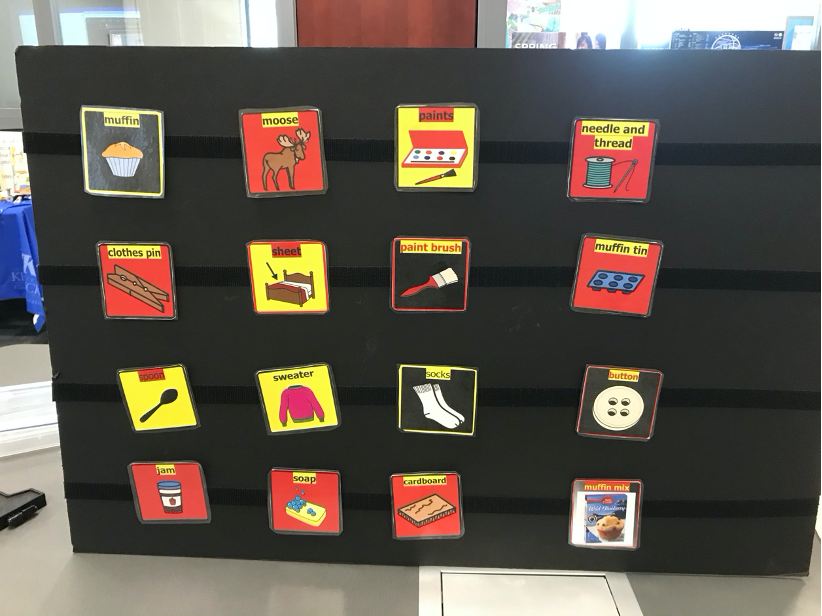
The cards are printed onto printer paper and glued using spray adhesive to heavy-duty card stock. I then used clear contact paper to cover them rather than laminating, as it created less glare.
As a display system, I made a Velcro board using a black foam board and attaching Velcro strips horizontally across the board (4 rows) as well as attaching Velcro to the back of my picture communication symbols. I used a small, plastic, waterproof container to store the cards when not in use. In addition, I was able to find an easel to use to hold up the foam board. I like the lay-out of the board as it could be used for as many or as few picture communication symbols as you need or in whatever array is beneficial for the student.
I used high contrast colors that would also be appropriate for individuals with cortical visual impairment and used large print and bold labels for each symbol. I attempted to keep the visual complexity of the photos at a minimum. In addition, I used the border tool to enhance the borders of the card symbols.
Some questions that might be used for comprehension include:
- What item did the Moose have first?
- What item did the Moose have last?
- What item did the Moose use to dry up the paint spill?
- What did the Moose always want with his muffin?
- What did the Moose want to use the socks for?
Talking Book
Here is the talking book I made using Powerpoint of my theme book “If You Give a Moose a Muffin”. I used low complexity and high-contrast pictures using the Boardmaker program.
All of the components of this project would be wonderful for all students, and especially for a student with visual impairments and multiple disabilities.

